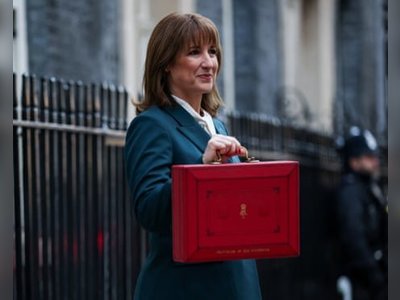
It’ll cost Johnson £14bn to keep his promises on social care. Will Javid pay up?
Restoring care standards even to 2010 levels will blow a big hole in the chancellor’s budget in March, says Guardian columnist Polly Toynbee
Under the nose of parliament, right there in Westminster, Garside House Nursing Home run by Sanctuary Care Ltd has just been given an “overall inadequate” rating from the Care Quality Commission. It is judged not “safe”, “effective”, “responsive” or “well-led” and requires improvement for “caring” in its 40 beds for people with dementia, disabilities and for end-of-life care. It is now in special measures and under investigation by the police over allegations of abuse and mistreatment.
The everyday horrors of social care pass barely reported these days, cruelties behind net curtains or inside institutional “homes” stay largely hidden. Brexit will worsen an already severe staffing crisis, with more than 580,000 new recruits required by 2035 to keep up with our ageing population, on top of the current 122,000 vacancies.
Boris Johnson pledged in his first speech as prime minister: “We will fix the crisis in social care once and for all, and with a clear plan we have prepared to give every older person the dignity and security they deserve.” No plan exists. Instead the Queen’s speech promised only to try to reach a “cross-party agreement” in an unlikely bid to co-opt or blame the opposition for the Tories’ failure. He offers a £1bn emergency bung to keep the collapsing system afloat a little longer.
Until the budget in March, the true complexion of this government remains opaque. Promises, vague assurances and aspirations for the north will flood the press, but only hard cash on the table will tell us who they are and what they intend. Johnson likes infrastructure he can brand his own, so northern railways can expect eye-catching investment. But how far will his chancellor – an Ayn Rand devotee and believer in a small state – burst the party’s self-imposed limits for current spending? We already know their priorities will be the NHS, police and schools – but what of everything else that has been parched dry by austerity, where the IFS notes that 14% cuts are already “baked-in”?
Let’s put that £1bn pledged for social care into context. Johnson promises people the “dignity and security they deserve and that no one who needs care has to sell their home to pay for it”. That’s two separate promises, with the second the most concrete and hardest to break. In 2014, following the Dilnot report, David Cameron’s government passed a law to fix this: the Care Act. The law fixed a £72,000 cap as the most anyone need spend on care before the state stepped in to pay the rest, so that those entering residential care would be less likely to have to sell their home to pay for it. But the £4bn cost was more than his chancellor George Osborne would tolerate: he postponed it to 2020, and then indefinitely.
There is no need for a new act to simply implement this – but it would cost £4bn. Yet that only compensates the better off for what they currently pay themselves, without adding anything to the desperate inadequacies of the care provided. It would, however, right the random injustice of dementia sufferers losing their homes and savings while those lucky enough to drop dead pay nothing. It may be fiscally regressive to spend £4bn on compensating the haves rather than improving bad care for all, but applying the principle of the NHS to social care – taking everyone out of life’s unfair health lottery – feels fair to most people, shocked when they first encounter the social care payment system.
What of the other part of the Johnson promise, his pledge to give “dignity and security” in care so lacking from the Garside House Nursing Home? Anita Charlesworth, director of research and economics at the Health Foundation, says that to return social care to the same standard and spending per head as in 2010 would now cost another £10bn. It’s not as if care in 2010 was anything to boast about, but the deterioration since has been shocking. Funding has dropped by £700m in real terms since 2010/11, resulting in 400,000 fewer people using the service than in 2010, at the beginning of the Tories’ first term. The threshold for qualifying for any care at all has risen so steeply that Age UK finds 1.4 million people are not receiving the care they need. Of these, 300,000 have “very substantial” needs. People are dying at home alone and uncared for, or are shipped into A&E at the last minute contributing to the NHS beds crisis – whose worst performance figures ever recorded are published today.
“Each year we delay, it gets worse,” says Charlesworth. She quotes a Competition and Markets Authority survey of the private care home sector: “The rates local authorities pay to care providers doesn’t provide enough for a quality service. Care homes used to cross-subsidise their state-funded patients with self-funders – but they can’t do that now. The result is the closure of nursing homes.”
Then there is the workforce crisis, which she says is due to low pay and poor conditions. A quarter of people in the social care sector are on zero-hours contracts – see Ken Loach’s latest gruelling exposé in Sorry We Missed You. The post-Brexit visa squeeze will do nothing to help the dire staffing situation: 40% of London care workers are from overseas.
This is the challenge for Boris Johnson’s first budget, which will reveal his true intent. Will he spend £14bn to rescue homeowners from forced sales and to restore social care at least to the bare standards of 2010? Garside House in special measures on his Westminster doorstep is only the latest warning.
The everyday horrors of social care pass barely reported these days, cruelties behind net curtains or inside institutional “homes” stay largely hidden. Brexit will worsen an already severe staffing crisis, with more than 580,000 new recruits required by 2035 to keep up with our ageing population, on top of the current 122,000 vacancies.
Boris Johnson pledged in his first speech as prime minister: “We will fix the crisis in social care once and for all, and with a clear plan we have prepared to give every older person the dignity and security they deserve.” No plan exists. Instead the Queen’s speech promised only to try to reach a “cross-party agreement” in an unlikely bid to co-opt or blame the opposition for the Tories’ failure. He offers a £1bn emergency bung to keep the collapsing system afloat a little longer.
Until the budget in March, the true complexion of this government remains opaque. Promises, vague assurances and aspirations for the north will flood the press, but only hard cash on the table will tell us who they are and what they intend. Johnson likes infrastructure he can brand his own, so northern railways can expect eye-catching investment. But how far will his chancellor – an Ayn Rand devotee and believer in a small state – burst the party’s self-imposed limits for current spending? We already know their priorities will be the NHS, police and schools – but what of everything else that has been parched dry by austerity, where the IFS notes that 14% cuts are already “baked-in”?
Let’s put that £1bn pledged for social care into context. Johnson promises people the “dignity and security they deserve and that no one who needs care has to sell their home to pay for it”. That’s two separate promises, with the second the most concrete and hardest to break. In 2014, following the Dilnot report, David Cameron’s government passed a law to fix this: the Care Act. The law fixed a £72,000 cap as the most anyone need spend on care before the state stepped in to pay the rest, so that those entering residential care would be less likely to have to sell their home to pay for it. But the £4bn cost was more than his chancellor George Osborne would tolerate: he postponed it to 2020, and then indefinitely.
There is no need for a new act to simply implement this – but it would cost £4bn. Yet that only compensates the better off for what they currently pay themselves, without adding anything to the desperate inadequacies of the care provided. It would, however, right the random injustice of dementia sufferers losing their homes and savings while those lucky enough to drop dead pay nothing. It may be fiscally regressive to spend £4bn on compensating the haves rather than improving bad care for all, but applying the principle of the NHS to social care – taking everyone out of life’s unfair health lottery – feels fair to most people, shocked when they first encounter the social care payment system.
What of the other part of the Johnson promise, his pledge to give “dignity and security” in care so lacking from the Garside House Nursing Home? Anita Charlesworth, director of research and economics at the Health Foundation, says that to return social care to the same standard and spending per head as in 2010 would now cost another £10bn. It’s not as if care in 2010 was anything to boast about, but the deterioration since has been shocking. Funding has dropped by £700m in real terms since 2010/11, resulting in 400,000 fewer people using the service than in 2010, at the beginning of the Tories’ first term. The threshold for qualifying for any care at all has risen so steeply that Age UK finds 1.4 million people are not receiving the care they need. Of these, 300,000 have “very substantial” needs. People are dying at home alone and uncared for, or are shipped into A&E at the last minute contributing to the NHS beds crisis – whose worst performance figures ever recorded are published today.
“Each year we delay, it gets worse,” says Charlesworth. She quotes a Competition and Markets Authority survey of the private care home sector: “The rates local authorities pay to care providers doesn’t provide enough for a quality service. Care homes used to cross-subsidise their state-funded patients with self-funders – but they can’t do that now. The result is the closure of nursing homes.”
Then there is the workforce crisis, which she says is due to low pay and poor conditions. A quarter of people in the social care sector are on zero-hours contracts – see Ken Loach’s latest gruelling exposé in Sorry We Missed You. The post-Brexit visa squeeze will do nothing to help the dire staffing situation: 40% of London care workers are from overseas.
This is the challenge for Boris Johnson’s first budget, which will reveal his true intent. Will he spend £14bn to rescue homeowners from forced sales and to restore social care at least to the bare standards of 2010? Garside House in special measures on his Westminster doorstep is only the latest warning.











